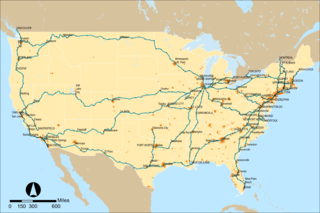 W
WThe National Railroad Passenger Corporation, doing business as Amtrak, is a passenger railroad service that provides medium and long-distance inter-city rail service in the contiguous United States and to nine cities in Canada.
 W
WAmtrak's 25 Hz traction power system is a traction power grid operated by Amtrak along the southern portion of its Northeast Corridor (NEC): the 225 route miles (362 km) between Washington, D.C. and New York City and the 104 route miles (167 km) between Philadelphia and Harrisburg, Pennsylvania. The Pennsylvania Railroad constructed it between 1915 and 1938. Amtrak inherited the system from Penn Central, the successor to Pennsylvania Railroad, in 1976 along with the Northeast Corridor. This is the reason for using 25 Hz, as opposed to 60 Hz, which is the standard for power transmission in North America. In addition to serving the NEC, the system provides power to NJ Transit Rail Operations (NJT), the Southeastern Pennsylvania Transportation Authority (SEPTA) and the Maryland Area Regional Commuter Train (MARC). Only about half of the system's electrical capacity is used by Amtrak. The remainder is sold to the commuter railroads who operate their trains along the corridor.
 W
WAmtrak operates a 60 Hz traction power system along the Northeast Corridor between New Haven, Connecticut, and Boston, Massachusetts. This system was built in the late 1990s and supplies locomotives with power from an overhead catenary system at 25 kV alternating current with a frequency of 60 Hz. The system is also commonly known as the Northend Electrification, in contrast to the Southend Electrification that runs from New York City to Washington, D.C.
 W
WAmtrak California is a brand name used by the California Department of Transportation (Caltrans) Division of Rail for three state-supported Amtrak commuter rail routes in California – the Capitol Corridor, the Pacific Surfliner, and the San Joaquins – and their associated connecting network of Thruway Motorcoach buses.
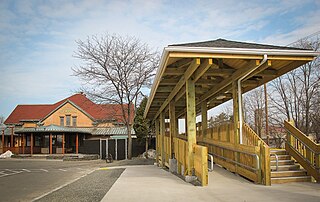 W
WThe Connecticut River Line is a railroad line owned by the Massachusetts Department of Transportation (MassDOT), that serves the "Knowledge Corridor" between Springfield and East Northfield, Massachusetts.
 W
WThe New York, New Haven and Hartford Railroad pioneered electrification of main line railroads using high-voltage, alternating current, single-phase overhead catenary. It electrified its mainline between Stamford, Connecticut, and Woodlawn, New York, in 1907, and extended the electrification to New Haven, Connecticut, in 1914. While single-phase AC railroad electrification has become commonplace, the New Haven's system was unprecedented at the time of construction. The significance of this electrification was recognized in 1982 by its designation as a National Historic Engineering Landmark by the American Society of Mechanical Engineers (ASME).
 W
WHarold Interlocking is a large railroad junction located in New York City. It is the busiest rail junction in the United States. It serves trains on Amtrak's Northeast Corridor and the Long Island Rail Road's Main Line and Port Washington Branch, which diverge at the junction.
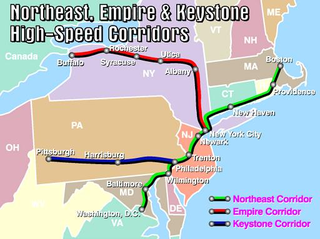 W
WThe Keystone Corridor is a 349-mile (562 km) railroad corridor between Philadelphia and Pittsburgh, Pennsylvania, that consists of two rail lines: Amtrak and SEPTA's Philadelphia-to-Harrisburg main line, which hosts SEPTA's Paoli/Thorndale Line commuter rail service, and Amtrak's Keystone and Pennsylvanian inter-city trains; and the Norfolk Southern Pittsburgh Line. The corridor was originally the Main Line of the Pennsylvania Railroad.
 W
WNational Train Day was a holiday started by Amtrak in 2008 as a method to spread information to the general public about the advantages of railway travel and the history of trains in the United States. It was held each year on the Saturday closest to May 10, the anniversary of the pounding of the Golden spike in Promontory, Utah, which marked the completion of the first transcontinental railroad in the U.S. Events were held at major Amtrak stations as well as railroad museums across the country and often have passenger cars and model railroad layouts on display. The largest events took place in Washington, D.C., Philadelphia, Chicago and Los Angeles. National Train Day was cancelled after 2015 due to budget cuts within Amtrak, although other rail organizations continue to observe the holiday.
 W
WNC By Train is a brand name used by the Rail Division of the North Carolina Department of Transportation (NCDOT) for two state-supported Amtrak routes operating in the U. S. state of North Carolina–the Carolinian and the Piedmont.
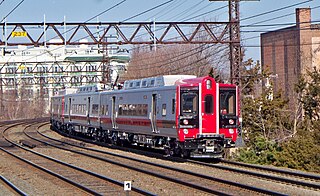 W
WMetro-North Railroad's New Haven Line runs from New Haven, Connecticut, southwest to Mount Vernon, New York. There it joins the Harlem Line, where trains continue south to Grand Central Terminal in Manhattan. The New Haven Line carries 125,000 passengers every weekday and 39 million passengers a year. The busiest intermediate station is Stamford, with 8.4 million passengers, or 21% of the line's ridership.
 W
WThe North–South Rail Link (NSRL) is a proposed rail tunnel, or pair of tunnels, that would connect North Station and South Station in downtown Boston, Massachusetts. The project would build new underground stations near the existing stations, connect them with about 1.5 miles (2.4 km) of tunnels, and add other tunnels to link up with existing surface tracks.
 W
WAmtrak has used a variety of liveries on its rolling stock since taking over intercity passenger rail service in the United States in 1971. A series of seven schemes termed Phases, first introduced in 1972, have seen the widest use. Phases primarily use geometric arrangements of red, white, and blue—the national colors of the United States—part of Amtrak's patriotic visual identity.
 W
WThe Amtrak Police Department (APD) is a railroad police agency and security organization that acts as the law enforcement arm of Amtrak, the government-owned passenger train system in the United States. It is headquartered at Union Station in Washington, D.C., and as of 2019 has a force of 452 sworn police officers, most of whom are stationed within the Northeast Corridor, Amtrak's busiest route.
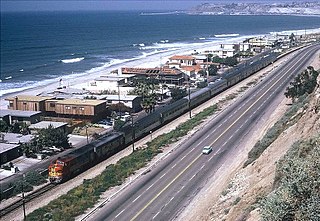 W
WThe Surf Line is a railroad line that runs from San Diego north to Orange County along California's Pacific Coast. It was so named because much of the line is near the Pacific Ocean, within less than 100 feet (30 m) in some places. The tracks are now owned by the Southern California Regional Rail Authority and the North County Transit District, and hosts Metrolink's Orange County Line and Inland Empire–Orange County Line, the San Diego Coaster, and Amtrak Pacific Surfliner passenger trains. The BNSF Railway operates freight over the line using trackage rights.
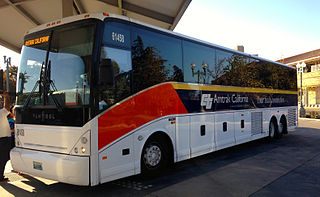 W
WAmtrak Thruway Motorcoach is system of through-ticketed routes to connect passengers with areas not served by Amtrak trains. As the name implies, in most cases these are dedicated motorcoach routes, but can also be non-dedicated intercity bus services operated by companies like Greyhound, transit buses, vans, taxis, ferry boats and commuter rail trains.
 W
WZoo Junction is an important junction on Amtrak's Northeast Corridor in Philadelphia, Pennsylvania where the Northeast Corridor meets the Keystone Corridor.